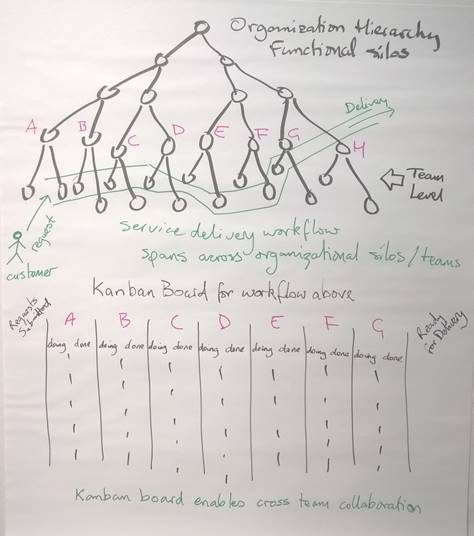Kanban Does Not Share Your Agile Cross-Functional Team Agenda
In November 2013 the Kanban coaching community agreed that we recognized 3 specific agendas that come with Kanban implementations: sustainability; service-orientation; and survivability. The first of these three is shared with Agile software development methodologies. The other two are distinctly unique to Kanban and its focus on improved service delivery and evolutionary change. However, Agile software development methodologies come with a distinct cross-functional team agenda. Kanban does not share this, nor does it need to in order to produce exceptional process improvement results. The Kanban approach is to visualize, improve transparency and understanding, reduce coordination costs through the use of boards. Visualize, Don’t Reorganize!
Agile consultants like to talk about teams a lot. My Kanban book talked about teams a lot too. And that was a mistake. I was using team to mean “a group of people who come together to achieve a common goal.” However, in Agile vernacular a team is actually an organizational unit, albeit, one that has been constructed to have a common goal or purpose, such as delivering working software. Agile Consultants generally set about reorganizing you into “teams” and when the work has variation and variety in it that require multiple specialist skills then these teams are referred to as cross-functional teams – teams containing multiple functions. The goal is to eventually cross-skill people on the team so that they are generalists who can perform all and any function, or T-shape people, who have a broad skillset at a shallow level of competence while maintaining a specialization in a single narrow skill with a deep level of competence.
The Agile bargain is that the pain of the reorganization will pay off in the performance of the new cross-functional teams, that they will achieve high levels of efficiency by eliminating delay in hand-offs between functions and eliminate coordination overhead between different functional groups. If you contain everything you need in a single organizational unit then you don’t have to worry about external dependencies. If these organizational units can be small, say 6 people, then coordination overhead should be minimal to non-existent.
And let’s just say that it works. Let’s not even challenge that theory with any performance data or anecdotal evidence that Agile organizations actually spend a lot of time and coordination overhead resolving dependencies and negotiating for scarce skills and availability of shared resources. Let’s ignore that often there aren’t enough scarce skilled people to go around and that bickering, in-fighting and land-grabbing behavior becomes common during Agile planning. Let’s ignore all of that and assume it works.
What I would like you to consider in this post is this, how expensive in time, money, stress and anxiety is the reorganization into these cross-functional teams? I’d like to posit that a large amount of the pain of Agile transitions and the large amount of the coaching needed for new Agile teams is caused by the stress of reorganizing into cross-functional teams. In other words, one of the reasons Agile is costing so much, is because of the cross-functional team agenda.

Kanban does not share Agile’s cross-functional team agenda. Instead Kanban solves this problem a different way. The diagram explains how. The upper half shows a simplified functional organizational hierarchy divided into 8 functions labeled A through H. Each of these functions is a functional team – a group of specialists in some skill or professional service.
The customer makes a request which involves provision of 7 of these services. The Agile solution to this would be to reorganize into teams with all 7 of these skills represented. Kanban takes a different approach. Kanban is the, “start with what you do now method” and that means you start with the organizational structure you have now. Instead Kanban asks us to model the workflow for the customer service request. We would do this using the STATIK (Systems Thinking Approach to Implementing Kanban) method taught in the 2-day Kanban Systems Design classes from Lean Kanban University. This would give us the Kanban Board displayed in the lower half of the diagram. The Kanban Board is said to be “service-oriented” because it models the required service from the customer’s perspective. The board enables members from all 7 teams to collaborate to deliver the service requests to the customer.
This diagram is simplified for pedagogical purposes. In reality the board design may not have a 1-1 mapping from functional team to column or state in the workflow. Some functions may happen in parallel or in an undefined sequence. We may choose to model activities to be performed using checkboxes on the tickets rather than columns on the board. There is a lot of subtlety and most of these nuances are covered in the training. A qualified Kanban Coaching Professional would be expected to provide guidance on when to model an activity on the board and when to model it on the ticket.
Kanban delivers on the definition of team, I envisaged when writing the Kanban book, “a group of people who come together to achieve a common goal.” The common goal is satisfying the customer request. It is a service-oriented goal. The board and the ticket design provide visualization and insight on the goal. We have plenty of case study evidence to show that this approach works. Many Kanban adopters report increased levels of collaboration at their firms and that this was achieved without painful reorganization, or allocating anyone a new role, responsibility or job title. Kanban improves collaboration through customer focused visualization and creating shared goals for dynamically formed teams of people drawn from different functional groups. With the right board design, it works for shared resources, shared services, functional silos, and of course, it will always work for existing cross-functional teams.
The results from Kanban have been impressive since the beginning. In 2005, the first kanban system spanned across three functional groups and resulted in 230% greater productivity, 90%+ reduction in lead times, and 0% to 98% improvement in predictability and on-time delivery performance. Since then these numbers have been shown to be somewhat mundane. 400% is often reported. 800% has been reported. 50%-90% drops in lead times are common. All of this is achieved without the pain of reorganizing into cross-functional teams; without the pain of Agile transition initiatives; without the cost of Agile transitions and the overhead of Agile coaching.
So even if the cross-functional team does deliver greatly reduced coordination overhead, and even if this does make them “awesome” and “hyper-productive”, and frankly that is a debate that really needs to be had, and if there was any reasonable data, it needs to be studied carefully, but let’s imagine it is all true, given that would it still be a lot faster, easier, cheaper and better to land 200-800% productivity gains, and 50-90% reduction in delivery times from starting with what you do now, and Kanbanizing it? Visualize, don’t reorganize!




